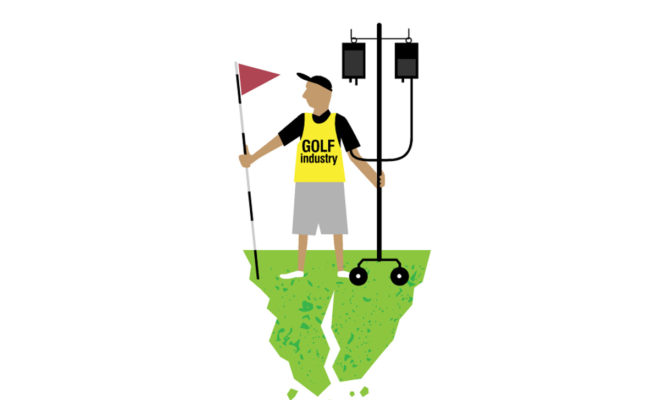Getting to the Root of the Problem: It’s the Land, Stupid!

Too much land that uses too much water to serve the too few who have received too much for too long from the too many who have more pressing needs.
That’s the way too much of the 91 percent of the population that doesn’t play golf thinks about the nine percent of us who do — pampered elites who encumber a disproportionate share of the common green space and the water necessary to keep it uncommonly pristine.
Is this a crude caricature? A gross distortion? A set of misconceptions practically rising to the level of a libel?
It’s all of that and more!The facts may favor us. But a simple recitation of facts to audiences not disposed to listening to them, or worse, to audiences whose minds are already made up to the contrary, won’t move this particular needle. Words have their place, but words alone soon become empty if that’s all one has to offer.
COVETING GOLF’S PROPERTY
It takes consistent attention on the consequences of the distorted lens placed upon the game, but more than that, it takes actions in support of a community value proposition that is as compelling to the game’s adherents as it is to those who are not inclined to ever put a golf club in their hand. Sermons about diversity, inclusion, equity, environmental sustainability, ecological integrity, health and character development ring hollow if not accompanied by concrete actions in support thereof. So do paeans to good intentions.
Before suggesting what some of those “concrete actions” might be, let’s get one thing straight up front. It’s the land, stupid! All of the game’s challenges are related to how much acreage it takes to provide a golf course. Whether it’s Assembly Member Cristina Garcia’s proposal to chop the state’s municipal golf courses into affordable housing tracts (AB 672), or certain environmentalists’ refrain about the game’s “frivolous” use of water, or Malcom Gladwell’s pique at the game’s property tax basis, or the canard about the “elite” nature of the game, the common denominator is the land the game encumbers.
It’s not the game or the game’s practitioners; it’s the land. And because of that fact – and yes, it’s a fact – golf has to work just that much harder to sell its societal value proposition than do other recreational and entertainment pursuits. If golf could be played on a bocce ball court, a tennis court, a soccer field, a baseball diamond, a pickleball court, a football field or any of the many other recreational activities that are easily pursued on a handful of acres, no one would care about who we are, what we do, how we do it, or who we do it with. And they certainly wouldn’t be coveting golf’s property for their preferred uses, whether recreational, residential or commercial.
WHETHER PUBLIC OR PRIVATE, IT BEHOOVES ALL SPECIES OF GOLF CLUB TO PERFORM ACTS OF PUBLIC SERVICE, INCLUDING ACTS OF CHARITY, IN THE SAME WAY THAT BUSINESSES ROUTINELY DO THEM.”
So, what’s a golf community thus challenged to do? The short answer is anything and everything capable of stitching golf courses into the fabric of the communities they inhabit in a way that causes those in the community who don’t golf to treasure their local golf course enough to think it’s worth keeping when someone comes along to suggest it be repurposed for a higher, better or different use, which, of course, can mean very different things in different communities.
But in every community, it means something. The trick is figuring what it means in each instance and then getting down to making it part of that golf course’s value proposition.
If the subject golf property is an urban municipal facility, the “community links” principles employed by golf course architects like Andy Staples and Forrest Richardson in the far West have proven up to the task by stitching much of the golf functionality so deeply into the functionality that supports other recreational and entertainment uses that it becomes impossible to deconstruct them without upending both, inextricably intertwining their fates, as it were.
Of course, that requires buy-in from a golf community often set in its ways. But when the choice is a binary one between collaborative coexistence and extinction, most golf communities make the right choice.
ACTS OF PUBLIC SERVICE
If the subject property is a daily-fee facility or private club, making sure that everything you do, suggest and/or support is consistent with a stance that obviates all hint of the elite aloofness that so many believe about you. Make sure that when attentions inevitably turn to drought and good environmental citizenship you are swimming with the political and social currents and not against them; that way, you’ll be indulged when trying to fashion those currents ever so slightly in your direction. Crash into those currents, and again, there’s that elite aloofness problem that causes so much collateral damage.
Whether public or private, it behooves all species of golf club to perform acts of public service, including acts of charity, in the same way that businesses routinely do them. Nothing can make it clearer that golf clubs and golf facilities consider themselves but small parts of a greater interdependent community as opposed to islands unto themselves. Beyond the individual to the much more impactful collective, if you’re one of the game’s leadership organizations or one of the game’s advocacy alliances like the California Alliance for Golf (CAG), understand that every position you take, every initiative you pursue and every word you utter will be judged by a world predisposed to believe much of the incendiary rhetoric at the top of this story. The actions you take will count for much more than the words you utter, and to the degree to which your actions contradict your words, you will have confirmed the worst that many believe about the game.
Whether municipal, daily fee, private, individual or collective, always remember that it is to the 91 percent who don’t play golf that the game’s actions and narratives must be addressed. How they understand what golf does and how it does it will determine how the game fares when its claim to its acreage is challenged.
The converted, the nine percent who play the game, require no preaching, but most of them are affiliated in one way or another with one of the game’s leadership organizations. It is to these leadership organizations that the task of preaching to the unconverted falls. How they execute it will decide whether golf shrinks or grows.
***
That’s the root of the problem. As for solutions more specific than the generalizations provided here, that’s the subject of another story much longer than this one. But if you want to get a flavor of how the SCGA very specifically posits a public narrative that hews to the generic rules and mandates summarized here, go to the Governmental Affairs Hub.










